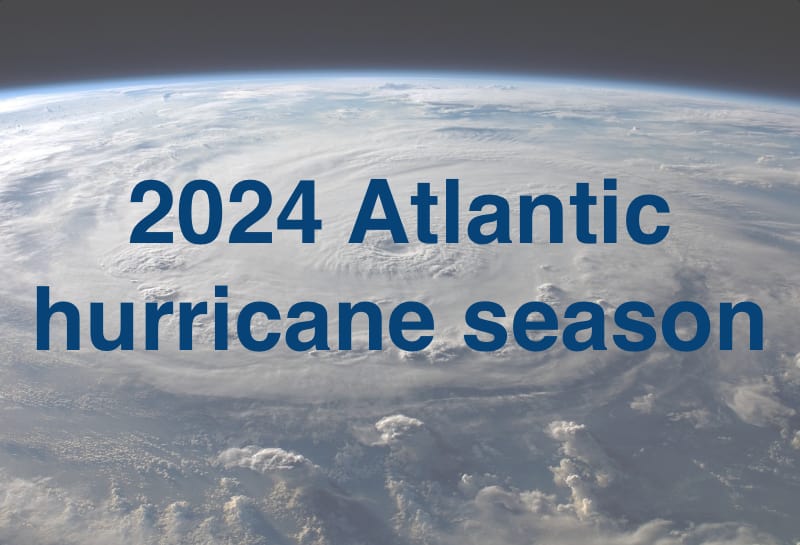75% chance of a hyperactive hurricane season in 2024: WeatherTiger

An increasing number of forecasters and meteorologists say to expect a very busy 2024 Atlantic hurricane season, with conditions looking primed for high levels of tropical cyclone activity and WeatherTiger’s models indicate a 75% chance the hurricane season will count as hyperactive, while its model also suggests elevated landfall risk for the United States.
“WeatherTiger’s analytical model quantifies these extreme initial conditions, issuing an initial projection of a 75% chance of a hyperactive hurricane season (>160 Accumulated Cyclone Energy units) in 2024 and a most likely outcome of total tropical activity nearly double long-term averages,” WeatherTiger co-founder and chief meteorologist Dr. Ryan Truchelut explained.
Adding, “This corresponds to odds of a normal (75-130 ACE) or above normal (>130 ACE) season of about 10% and 90%, with little chance of a below normal year (<75 ACE).”
Truchelut likens the hurricane season to leisurewear, quipping, “The available sizes for the upcoming hurricane season seem to range from L, at minimum, all the way up to XXXXL.”
Truchelut is clearly anticipating a busy season for storm formation, with factors related to sea surface temperatures and the expected La Nina favourable conditions, cited as set to assist the tropics in becoming particularly active.
“The Tropical Atlantic is as energetic now as it typically would be in mid-June,” Truchelut explained. “While Atlantic SST anomalies can change with weather patterns through summer, even if the Tropical Atlantic warmed up the least it ever has warmed between now and September, it would remain well above average for the peak of hurricane season. In short, there is high confidence that the Atlantic MDR will be strongly conducive for storms this summer and fall.”
He expects El Nino to dissipate by the time of WeatherTiger’s next seasonal outlook in late May.
Going on to explain, “Our internal El Nino/La Nina model and a preponderance of other guidance suggests that the Pacific will proceed straight into La Nina this summer, with an 80% chance of weak or moderate La Nina conditions by the most active months of hurricane season. This would keep upper-level winds favorable for hurricane development in the western Atlantic and Caribbean during August and September. Even if La Nina was slower to develop, the cool-neutral SSTs that likely would characterize the Central Pacific instead also historically favor above-average Atlantic hurricane seasons. With no realistic hope of an early fall El Nino from observations or models, don’t expect a Pacific bailout in 2024.”
The core uncertainty for the 2024 Atlantic hurricane season is “whether the upcoming hurricane season will be crazy busy, or merely pretty busy,” Truchelut said.
“Our conservative assumption is that 2024 will join a select group of just eight years since 1950 for which the Pacific is at least a little cooler and the Atlantic MDR at least 0.5°C warmer than average during the peak season. Six of those eight analogous Atlantic hurricane seasons were “hyperactive,” tallying 60 to 150% more total tropical activity than an average year,” he continued.
“The ’24 season has a 50-50 shot of landing in the ranges of 160-225 ACE, 20-24 tropical storms, 9-12 hurricanes, and 4-7 major hurricanes,” Truchelut said.
Which puts that WeatherTiger forecast right in the ballpark of those we’ve covered so far this year, indicating a growing consensus for high to very high Atlantic tropical storm activity levels in 2024.
Helpfully, Truchelut provides some context to help in thinking about what a warm Atlantic could mean for hurricane landfall risk in 2024.
“The relationship between net Atlantic hurricane activity and the resulting severity of U.S. impacts is weaker than you might think, but since 1900 U.S. major hurricane landfall risks roughly double between cool Atlantic and warm Atlantic years, and are almost 2.5 times higher in La Nina versus El Nino years,” he explained. “Still, the variability in U.S. landfall outcomes between seasons with similar set-ups can be huge.”
“WeatherTiger’s landfall risk model predicts a 55% chance that continental U.S. tropical impacts in 2024 land in the upper third of all hurricane seasons since 1900. That’s an elevated risk of U.S. landfalls, but a bit more equivocal an outlook than our overall activity guidance,” Truchulet said.
It’s still a bit far out for landfall probability forecasts to hold a great deal of weight with most in the industry, but conditions are primed for a busy year which always means those on the insurance, reinsurance and catastrophe bond side of things will need to be alert as we move through the nest few months towards the official start of the hurricane season.
An elevated level of landfall risk and even actual landfalling hurricanes does not always translate into significant insurance and reinsurance market losses, with landfall locations critical to defining the ultimate human and financial costs from a storm.
But preparing for the season with insights that can help in understanding the climate conditions that may drive storm activity is a good place for the industry to start, this far out.
There are a number of forecasts anticipated over the coming few weeks that may give further credence to the expectation 2024 will be particularly busy in the Atlantic tropics.
One other forecast data point we’ve seen comes from StormGeo, with that company calling for 21 named tropical storms to form, with 11 becoming hurricanes and 5 intense hurricanes of Category 3 or greater in the Atlantic in 2024.
Again, that’s a well above-normal Atlantic seasonal hurricane forecast and it is aligned with all of the others we’ve seen so far.
Track the 2024 Atlantic tropical storm and hurricane season on our dedicated page and we’ll update you as new information emerges.






